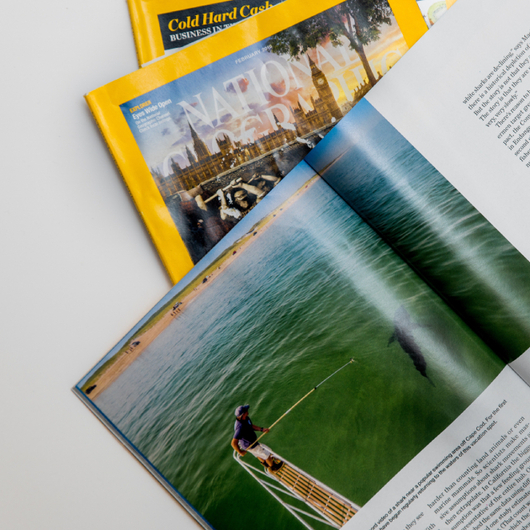
A Case Study on Tesla and Innovation
Tesla Motors: Inspiration in Design, Innovation in Marketing
Read MoreQuick! What’s the first thing that comes to mind when you hear the words National Geographic? Page after page of breathtaking photographs? Comprehensive travelogues? Full-color foldout maps of remote corners of the globe? The trademark citrus-yellow border and spine?
I’m guessing that for a lot of you, Twitter, Facebook, or Instagram didn’t immediately pop into your head. But they should have. Because while National Geographic has earned a place of prominence in the pantheon of periodicals, this 130(plus)-year-old legacy brand now finds itself the king of the jungle in the digital age. As you’re about to find out, this revered, reliable source is anything but musty and old-fashioned.
“Dear Sir,” the letter read, “You are invited to be present at a meeting … for the purpose of considering the advisability of organizing a society for the increase and diffusion of geographical knowledge.” And so it began. The 33 men who showed up at Washington, DC’s Cosmos Club on the appointed evening, in January 1888, determined that it was indeed advisable to organize a geographical society, along the lines of other learned bodies of the day (think the Smithsonian Institution).
Calling itself the National Geographic Society, this new organization wasted no time in publishing its first journal, which came out two months later. But what it produced for those charter members was a far cry from the eye-catching, award-winning glossy magazine National Geographic would eventually become. The first iteration of this book was bound in simple brown covers and contained no photographs in its pages—only erudite articles covering topics such as “Geographical Methods in Geological Investigation” and “The Great Storm of March 11–14, 1888.”
With 136 million Instagram followers, National Geographic excels at the engagement game.
We have Alexander Graham Bell to thank for broadening the reach of the magazine and sprucing up its appearance. As president of the society at the turn of the 20th century, Bell wanted to appeal to a wider range of readers, not just the scientific community the journal currently served. The man who is best known for inventing a device that revolutionized verbal communication believed that a visually stimulating magazine was the best vehicle for conveying the society’s theme: The World and All That Is in It.
Under Bell’s watch, editor Gilbert H. Grosvenor increased readership by introducing first-person travel narratives à la Charles Darwin’s The Voyage of the Beagle and Richard Henry Dana Jr.’s Two Years Before the Mast. And, in what WIRED called a “game-changing decision,” the young editor gave photographs a place of prominence, albeit initially not by design. “Surprisingly, National Geographic’s hallmark photojournalism began as a desperate attempt to fill 11 pages of the January 1905 issue before it went to press,” WIRED wrote.
Evocative photos, captivating travelogues, and tales of epic adventure and discovery became hallmarks of the monthly magazine, and over its 130-plus years in publication, it has carved a niche for itself as a trusted source for in-depth travel, exploration, wildlife, conservation, and scientific reporting and photojournalism. With a worldwide circulation in the millions, and published in 38 languages and distributed to 171 countries, the well-established and beloved print publication might have been tempted to rest on its laurels. But in the true spirit of exploration it extols, the National Geographic Society has blazed a few (digital) trails of its own in the past decade or so.
“Why are island birds losing their ability to fly?” the tweet asks. In an eye-catching photo accompanying it, a white-beaked, green-tufted kakapo appears to be tiptoeing (tipclawing?) its way toward the camera. Click on the link and you’re taken to National Geographic’s website, where more avian photos await, along with a detailed story explaining the flightless-bird phenomenon.
Or up pops a video of a man swimming sans wetsuit in the icy sea between a pair of imposing glaciers, and we’re duly intrigued to watch the full clip to find out just what this intrepid soul is up to. Spoiler: The former Adventurer of the Year was swimming through the environmentally threatened waters of Antarctica to raise awareness for three marine-protected areas.
Welcome to @NatGeo on Twitter, where science is cool and nature fascinates, and you’ll find captivating articles on a multitude of disparate topics. Many are accompanied by vivid photos, and more often than not, links direct readers to full-length stories on National Geographic’s website.
Welcome to @NatGeo on Twitter, where science is cool and nature fascinates.
Pay a visit to National Geographic’s Facebook page, and you’ll discover much the same thing—attractive preview photos or videos with thumbnails that draw you in and make you want to learn more. We can satisfy our curiosity by reading an Instant Article on our mobile device or, if we’re using a computer, we can click on a link to related content on the publisher’s website. Which, as Aaron Taube pointed out on Contently, is exactly what the publisher had in mind: “The goal is to make the audience curious about science, and with titles like ‘Why Flashy Male Birds Aren’t What They Seem’ and ‘How Not to Get Attacked by a Bear,’ the Facebook posts do a great job of generating interest.”
And then there’s what many consider the pièce de résistance, National Geographic’s Instagram feed, which showcases the work of dozens of staff photographers and freelancers stationed around the world who are given free rein to share images from the assignments they shoot, as well as photos of unusual natural wonders they encounter in their everyday lives.
With 130+ million Instagram followers, National Geographic excels at the engagement game. “They build a sense of community with National Geographic’s Instagram followers, who see photos coming from talented individuals rather than a generic corporate account. As a result, users end up researching and following personal accounts for the photographers, maximizing the brand’s Instagram reach and leading to further engagement,” Taube wrote.
“They build a sense of community with National Geographic’s Instagram followers, who see photos coming from talented individuals rather than a generic corporate account.”



This level of Instagram success has rocketed National Geographic to the top of the social media stratosphere. A report in September 2015 that monitored all social media activity showed National Geographic far outdistancing the Bleacher Report and several BuzzFeed properties, among others. On Twitter and Facebook, National Geographic occupies the top spot in this publication group, and on Pinterest, it ranks sixth (at the time of this writing). This is quite an impressive showing for a relative newcomer to digital, and it should come as no surprise that these rankings are directly related to the publication’s exceptional content. But in order for the respected print publication to establish a solid social media footprint, it had to temper the desire to educate—using its wealth of detailed, scholarly information—with the push to entertain, employing easily understood content and its trademark jaw-dropping images. In a blog he wrote for the Aloft Group, Brayden Rudert summed up the balancing act: “Ultimately, they [National Geographic] had to find the perfect combination of educational material to maintain their professional relevance while also providing quick and efficient content to entertain consumers less interested in the science and more intrigued by the Earth’s visual beauty and opportunity for adventure.”
In a blog titled “How National Geographic Drives Giant Facebook, Twitter, and Instagram Engagement,” Lucy Hitz spotlighted a 2014 Instagram post that exemplifies National Geographic’s social media finesse and also honors its outdoor-authority heritage. The post, which garnered 40,000 likes in a single day, featured a photo of a Hawaiian surfer hauling a 50-pound boulder across the ocean floor as part of her training regimen. (You read that right—50 pounds, under water!) With its well-executed photography, intriguing subject matter, and human vs. nature dynamic, the post epitomized the National Geographic brand. “It’s the perfect post,” Hitz wrote. She gave it high marks for its succinct but compelling description of what the photo was all about, “making the post a mini magazine story.” What’s more, discovery was optimized, with tags for the photographer, the reporter, the woman in the photo, and National Geographic itself.
Across all digital media, National Geographic masterfully engages audiences by delivering timely, relatable, and relevant content while staying true to its hallmarks: exploration and storytelling.
With an eye to nabbing a younger audience, National Geographic uses Snapchat to provide interactive content like quizzes (inviting the audience to become a part of the brand), along with photos and videos. And Pinterest helps the brand cater to fans’ passions, like photography, wildlife, travel, or environmental issues.
Across all digital media, National Geographic masterfully engages audiences by delivering timely, relatable, and relevant content while staying true to its hallmarks: exploration and storytelling. National Geographic has perfected the balance of staying true to their brand, while also growing with and embracing new technology.
Let’s face it—this well-preserved century-old brand has come a long way. It’s done what many other publishers have failed to do. First and foremost, National Geographic understands its audience’s wants and needs and caters to them. They also encourage dialogues over monologues—they want to be able to build relationships and engage with their customers, not preach to them. They have taken what they already knew and had established with their followers, and they have repurposed it to make it creative and applicable to today’s social media strategies. In early 2019, National Geographic became the first brand to exceed 100 million Instagram followers, due in part to their extensive social advertising campaigns that boosted their revenue by 80%. Namely, National Geographic has become as dominant online as it is in print. The Aloft Group’s Rudert put it best: “Plain and simple, National Geographic is creating killer content, and people just can’t seem to get enough [of] it.”

Tesla Motors: Inspiration in Design, Innovation in Marketing
Read More
In late 2018, the very first ‘virtual store’ emerged in a Starbucks in China, offering customers a digital and personal customer experience like no other.
Read More